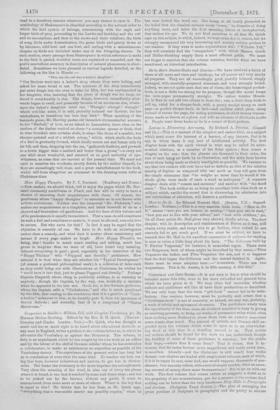Crimmins AND Gier-BooKs.--It is not easy to know what should
be included under this title, even in the more extended and, general form which we have given to it. We very often feel uncertain whether authors and publishers will like 16 have their productions so described. We can only hope that the term "gift-hook " cannot fail to be rattle- factory. Our readers, however, must be perfectly well aware that a " Christmas-book" is not of necessity, or indeed, we may say, probably, a work of trivial and ephemeral character. The publishers wisely take. the opportunity of the time when all civilized mankind is busy in giving or receiving presents, to bring out works of permanent value which often havo nothing more distinctive about them than an exterior somewhat more ornate than usual. The amount of artistic mid literary skill ex- pended upon the volumes which come in upon us in an overwhelm- ing flood at this time is a standing marvel to us. That artists and writers should be found for the work we can understand, though the fertility of some of these gentlemen is amazing.; but the public, that buys,—where does it come from ? That it comes, that it in- creases, that its tastes become more magnificent and costly every year, is manifest. Already—and the Christmas is still nearly four weeks distant—our shelves are loaded with resplendent volumes, each of which, if it is to repay its cost, must find, one would suppose, thousands of pur- chasers. One can only reflect, with a sort of stupid wonder, what an amaz- ing amount of money there must be somewhere I But to go on with our work. The first volume that comes before us suggests a doubt as to the propriety of our nomenolature, yet for a present of the serious kind nothing can be bettor than the very handsome Holy Bible in Paragraphs and Sections. (Religious Tract Society.)--The plan of arranging the prose portions of Scripture in paragraphs and the poetry in stanzas is one which has already met with general approval. The edition boforo us also contains suggested emendations of the translation,—
which are incorporated with the toxt, the suggested render- ing being includtal in brackets,—a running summary of the con- tents, chronological tables, maps which strike us as being remarkably good (that of tho Holy Land with the D ;sort of the Exodus included, should be particularly noticed), marginal references, dio. The editors are Dr. Gotch for the Old Testament, Dr. Jacob for the New.---In limes of Other Days (Triibner) Mr. Thomas Wright works up, with large additions, materials with which some of our readers may havo h000me acquainted in his 'History of Domostio Manners and Seal- moats in England during the Middle Ages," a description which he adds Its a second title to the volume beforo us. Mr. Wright's reputation as an antiquary is, as our rea lore are aware, of tho highest ; but it is not every antiquary, however learned, who knows how to work up his materials with such skill. The volume is of the most entertaining kind. Ono is not indisposed occasionally to turn aside from the records of wars and polities, oven if ono does not follow Canon Kingsley in giving them up in despair, to poop at the under-current of daily life, to learn how our ancestors ate and drank and slept and amused them- selves. The book divides itself into four periods, which may be roughly described as the Anglo-Saxon, tho Norman, the Early English, and a later time which brings us as far down as tho days of tho Common- wealth. It contains an immense fund of the most varied information about the manners and customs of those times. —To Cabinet Pictures (Macmillan) the epithet " Christmas " may be undoubtedly applied, but it can hardly bo called a "book." It is, in fact, a portfolio containing fivo handsome chromolithographs. The subjects are " Child° Harold's Pilgrimage "(Turner), "Crossing the Bridgo " (Caloott), " The Corn- cold" (Constable), (Constable), "A Landscape" (Birkot Foster), "The Fighting Tbmcirairo "(Turner). All seem well oxooutod ; our own preference, -duo more perhaps to old love of the pioturo than to the superiority of this reproduction of it, would be given to the first. Certainly it gives In a worthy manner one of the best spoolmons of Turner's most popalar manner. The "Fighting Ttirruirairo "is also very good.— Genie of Dutch Art (Sampson Low and Co.), is a series of twelve photographs taken from engravings in the British Museum of some pictures of the best Dutch masters. Three of the twelve are from Adrian Van Undo, and among the rest the names of Van Miens, Jun Steen, and Dusart may be noticed. The way in which these pictures are reproduced seems' to us to be 'especially suited to this kind of art. "The Drinker," " Tho Cottage- Door," and "The Spinner" seem to us as good as anything of the sort which we have seen before. Mr. G. W. Reid, Keeper of the Prints in the British Musoum, supplies descriptive notes, with brief memoirs of the artiste. —Pictures by Leslie (Virtue) is a handsome volume, which will no doubt approve itself to tho taste of many. Our own taste does not much incline to this painter, "of whom we should be disposed to say
that he is not real enough nor imaginative enough ; nevertheless, there ,can be no doubt about the merits of such pictures as " Sancho Palma and
the Duobess," "Le Bourgeois Goutilhomino"—where Nicole the house- maid disturbs the learner of fencing by her vigorous thrusts—" Florizol and Perdita," Jo. Mr. J. Dalforne gives dosoriptions of the pictures, and a short biography of the artist.



































 Previous page
Previous page